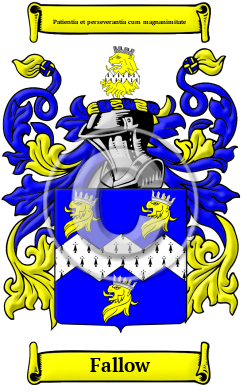| ![Show Contents]() Fallow History, Family Crest & Coats of Arms Fallow History, Family Crest & Coats of Arms
- Origins Available:
England Etymology of FallowWhat does the name Fallow mean? The name Fallow comes from the ancient Anglo-Saxon culture of Britain. It was a name for a friend or comrade. The surname Fallow originally derived from the Old English word Feolaza which affectionately meant "partner" or "shareholder." As a surname, it was likely taken on by a member of a trade guild. "Besides its more proper meaning of ' companion,' the word Fellow is used in some dialects to signify a young unmarried man, or a servant engaged in husbandry. Chaucer uses the phrase 'a proper felawe' to denote a well-formed young man." 1 Early Origins of the Fallow familyThe surname Fallow was first found in Huntingdon. However another branch of the family was later found at Shotesham in Norfolk. "Shotesham Park, the seat of Robert Fellowes, Esq., is a handsome mansion, erected by the late Mr. Fellowes, near the site of the ancient Hall, which was surrounded with a moat. " 2 Walter Felagh was one of the first records of the family. He was listed in the Assize Rolls of Northumberland in 1256. Robert le Felagh was listed in the Subsidy Rolls of Sussex in 1327. 3 John Felagh was listed in Somerset, 1 Edward III (during the first year's reign of Edward III.) 4 Early History of the Fallow familyThis web page shows only a small excerpt of our Fallow research. Another 121 words (9 lines of text) covering the years 1820 and 1910 are included under the topic Early Fallow History in all our PDF Extended History products and printed products wherever possible. Fallow Spelling VariationsOnly recently has spelling become standardized in the English language. As the English language evolved in the Middle Ages, the spelling of names changed also. The name Fallow has undergone many spelling variations, including Fellow, Fellows, Fellowes, Felloe and others. Early Notables of the Fallow familyMore information is included under the topic Early Fallow Notables in all our PDF Extended History products and printed products wherever possible.
| Fallow migration to the United States | + |
To escape the unstable social climate in England of this time, many families boarded ships for the New World with the hope of finding land, opportunity, and greater religious and political freedom. Although the voyages were expensive, crowded, and difficult, those families that arrived often found greater opportunities and freedoms than they could have experienced at home. Many of those families went on to make significant contributions to the rapidly developing colonies in which they settled. Early North American records indicate many people bearing the name Fallow were among those contributors:
Fallow Settlers in United States in the 19th Century- P J Fallow, who arrived in San Francisco, California in 1851 5
| Fallow migration to Australia | + |
Emigration to Australia followed the First Fleets of convicts, tradespeople and early settlers. Early immigrants include: Fallow Settlers in Australia in the 19th Century- Mr. John Fallow, (b. 1805), aged 24, Irish servant who was convicted in County Mayo, Ireland for life for theft, transported aboard the "Eliza" on 2nd March 1829, arriving in Tasmania (Van Diemen's Land), he died in 1838 6
- Miss Biddy Fallow, (Kiely), (b. 1810), aged 39, Irish servant who was convicted in Galway, Ireland for 10 years for stealing, transported aboard the "Earl Grey" on 17th December 1849, arriving in Tasmania (Van Diemen's Land), she was murdered in 1869 7
The motto was originally a war cry or slogan. Mottoes first began to be shown with arms in the 14th and 15th centuries, but were not in general use until the 17th century. Thus the oldest coats of arms generally do not include a motto. Mottoes seldom form part of the grant of arms: Under most heraldic authorities, a motto is an optional component of the coat of arms, and can be added to or changed at will; many families have chosen not to display a motto.
Motto: Patientia et perseverantia cum magnanimitate
Motto Translation: Patience and perseverance with magnanimity.
- Lower, Mark Anthony, Patronymica Britannica, A Dictionary of Family Names of the United Kingdom. London: John Russel Smith, 1860. Print.
- Lewis, Samuel, A Topographical Dictionary of England. Institute of Historical Research, 1848, Print.
- Reaney, P.H and R.M. Wilson, A Dictionary of English Surnames. London: Routledge, 1991. Print. (ISBN 0-415-05737-X)
- Dickinson, F.H., Kirby's Quest for Somerset of 16th of Edward the 3rd London: Harrison and Sons, Printers in Ordinary to Her Majesty, St, Martin's Lane, 1889. Print.
- Filby, P. William, Meyer, Mary K., Passenger and immigration lists index : a guide to published arrival records of about 500,000 passengers who came to the United States and Canada in the seventeenth, eighteenth, and nineteenth centuries. 1982-1985 Cumulated Supplements in Four Volumes Detroit, Mich. : Gale Research Co., 1985, Print (ISBN 0-8103-1795-8)
- Convict Records Voyages to Australia (Retrieved 17th February 2022). Retrieved from https://convictrecords.com.au/ships/eliza
- Convict Records Voyages to Australia (Retrieved 18th August 2021). Retrieved from https://convictrecords.com.au/ships/earl-grey
 |

